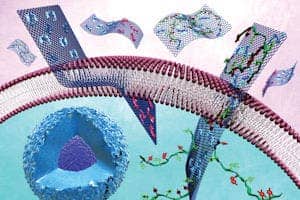A while ago I wrote that the applications for graphene are endless, and it seems like scientists just want to prove me right – University of Manchester scientists have used graphene to target and neutralise cancer stem cells while leaving healthy cells unharmed.
Graphene is the new “wonder kid” in the world of material science – it’s basically a one atom thick sheet of carbon with some amazing properties. It is about 100 times stronger than steel by weight, conducts heat and electricity with great efficiency and is nearly transparent. Researchers already have great things in mind for graphene – it could make the internet 100 times faster and usher away silicon from transistors and microprocessors – but practical applications already exist: we already have graphene sensors, graphene radios and even graphene headphones. Now, they want to further extend the potential applications to medicine.
The team led by Professor Michael Lisanti and Dr Aravind Vijayaraghavan has shown that graphene oxide acts like an anti-cancer agent that selectively targets and kills cancerous cells, while leaving healthy ones unharmed.
“Cancer stem cells possess the ability to give rise to many different tumour cell types. They are responsible for the spread of cancer within the body – known as metastasis- which is responsible for 90% of cancer deaths. They also play a crucial role in the recurrence of tumours after treatment. This is because conventional radiation and chemotherapies only kill the ‘bulk’ cancer cells, but do not generally affect the CSCs”, said Professor Lisanti.
However, this shouldn’t be touted as a “cure for cancer” – not yet, anyway. The treatment still needs to undergo several years of testing even before this is tested on humans. Still, the fact that graphene could be applied medically is extremely exciting. Dr Vijayaraghavan added:
“Graphene oxide is stable in water and has shown potential in biomedical applications. It can readily enter or attach to the surface of cells, making it a candidate for targeted drug delivery. In this work, surprisingly, it’s the graphene oxide itself that has been shown to be an effective anti-cancer drug.
“Cancer stem cells differentiate to form a small mass of cells known as a tumour-sphere. We saw that the graphene oxide flakes prevented CSCs from forming these, and instead forced them to differentiate into non-cancer stem-cells.
“Naturally, any new discovery such as this needs to undergo extensive study and trials before emerging as a therapeutic. We hope that these exciting results in laboratory cell cultures can translate into an equally effective real-life option for cancer therapy.”]
The team tested the graphene oxide against six types of cancer – breast, pancreatic, lung, brain, ovarian and prostate. The graphene flakes inhibited the formation of tumors in all six types, and it worked out spectacularly, suggesting that graphene can work effectively against all types of cancer. The researchers suggest that, used in combination with conventional cancer treatments, the overall outcome may be even better.
Dr Federica Sotgia, one of the team members concluded:
“These findings show that graphene oxide could possibly be applied as a lavage or rinse during surgery to clear CSCs or as a drug targeted at CSCs. Our results also show that graphene oxide is not toxic to healthy cells, which suggests that this treatment is likely to have fewer side-effects if used as an anti-cancer therapy.”
Source: University of Manchester.










